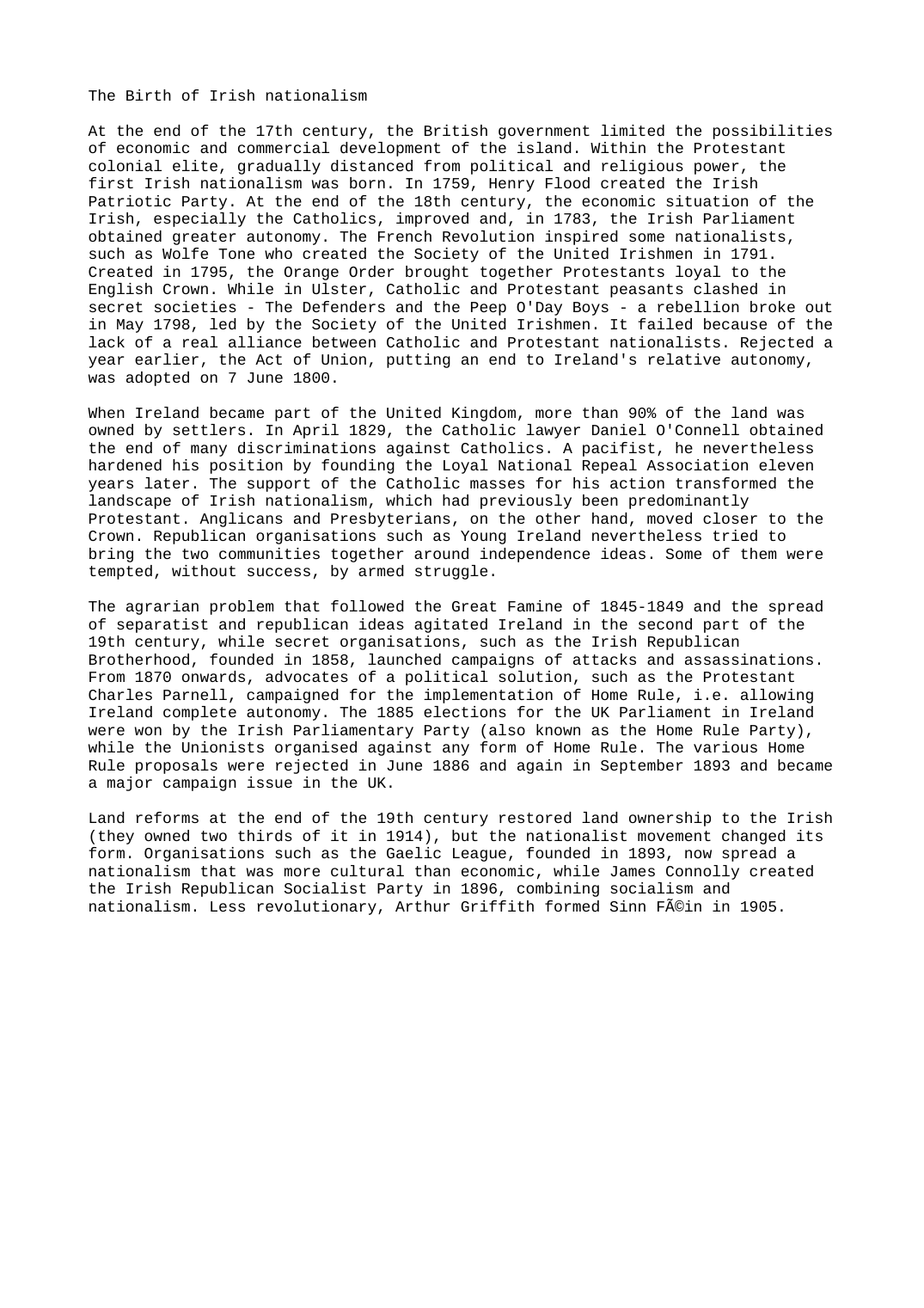The birth of Ireland nationalism
Publié le 24/02/2022

Extrait du document
«
The Birth of Irish nationalism
At the end of the 17th century, the British government limited the possibilities
of economic and commercial development of the island.
Within the Protestant
colonial elite, gradually distanced from political and religious power, the
first Irish nationalism was born.
In 1759, Henry Flood created the Irish
Patriotic Party.
At the end of the 18th century, the economic situation of the
Irish, especially the Catholics, improved and, in 1783, the Irish Parliament
obtained greater autonomy.
The French Revolution inspired some nationalists,
such as Wolfe Tone who created the Society of the United Irishmen in 1791.
Created in 1795, the Orange Order brought together Protestants loyal to the
English Crown.
While in Ulster, Catholic and Protestant peasants clashed in
secret societies - The Defenders and the Peep O'Day Boys - a rebellion broke out
in May 1798, led by the Society of the United Irishmen.
It failed because of the
lack of a real alliance between Catholic and Protestant nationalists.
Rejected a
year earlier, the Act of Union, putting an end to Ireland's relative autonomy,
was adopted on 7 June 1800.
When Ireland became part of the United Kingdom, more than 90% of the land was
owned by settlers.
In April 1829, the Catholic lawyer Daniel O'Connell obtained
the end of many discriminations against Catholics.
A pacifist, he nevertheless
hardened his position by founding the Loyal National Repeal Association eleven
years later.
The support of the Catholic masses for his action transformed the
landscape of Irish nationalism, which had previously been predominantly
Protestant.
Anglicans and Presbyterians, on the other hand, moved closer to the
Crown.
Republican organisations such as Young Ireland nevertheless tried to
bring the two communities together around independence ideas.
Some of them were
tempted, without success, by armed struggle.
The agrarian problem that followed the Great Famine of 1845-1849 and the spread
of separatist and republican ideas agitated Ireland in the second part of the
19th century, while secret organisations, such as the Irish Republican
Brotherhood, founded in 1858, launched campaigns of attacks and assassinations.
From 1870 onwards, advocates of a political solution, such as the Protestant
Charles Parnell, campaigned for the implementation of Home Rule, i.e.
allowing
Ireland complete autonomy.
The 1885 elections for the UK Parliament in Ireland
were won by the Irish Parliamentary Party (also known as the Home Rule Party),
while the Unionists organised against any form of Home Rule.
The various Home
Rule proposals were rejected in June 1886 and again in September 1893 and became
a major campaign issue in the UK.
Land reforms at the end of the 19th century restored land ownership to the Irish
(they owned two thirds of it in 1914), but the nationalist movement changed its
form.
Organisations such as the Gaelic League, founded in 1893, now spread a
nationalism that was more cultural than economic, while James Connolly created
the Irish Republican Socialist Party in 1896, combining socialism and
nationalism.
Less revolutionary, Arthur Griffith formed Sinn Féin in 1905..
»
↓↓↓ APERÇU DU DOCUMENT ↓↓↓
Liens utiles
- Education in Great Britain? Education is compulsory from the age of 5 (4 in Northern Ireland) to theage of 16.
- Founder State of the Commonwealth, the United Kingdom comprises England,Northern Ireland, Scotland and Wales.
- At the end of 1994, the opening of negotiations between Ireland and theUnited Kingdom about the autonomy of Northern Ireland marked adevelopment in a situation deadlocked since 1920, the date of partitionby the British into Catholic majority Ireland and Protestant majorityNorthern Ireland.
- Hanif Kureishi - The Buddha of Suburbia
- does the end justifies the means


